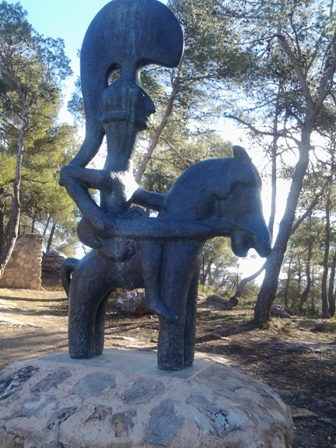Glory Days: Valencia’s Silk Guild Museum
The 18th June 2016 was the end of a long road and the opening up of a new horizon for Vicente Genovés. On that date, the old Valencian silk guild building opened to the public after years of abandon and broken local government promises.
For 25 years Vicente had been part of the guild, founded as long ago as 1479, one of the most important in Europe, dating back to the times when Valencia was a centre for the silk trade, situated at the western extreme of the Silk Route, which brought the raw product from Europe, where it was transformed into high quality clothing.
After 10 of those 25 years he joined the board, and was involved in the Project to recover the old building and restore it to its glory days, a Project launched in 2007.
In 2009, with the death of the old president, Vicente took over that role, and after many years of negotiations and listening to unkept promises from the local authorities, he turned to a private patron, the Hortensia Herrero Foundation, which undertook the task, and, two million euros, 6 years and 68,000 hours of labour later, the doors opened, with the 6,000 visits in the first month demonstrating that Valencia had not forgotten the importance of silk in its past prosperity, and that the city had another attraction for the demanding tourists who visit the city looking for more tan sun, sand and sangría.
 In the museum, with the aid of audio-visuals and authentic, functioning looms, visitors can discover in Spanish, Valencian and English, how the silk process is carried out, from worm to gown, and the role that silk played in Valencia’s history, and especially its architecture, paying as it did for at least two of Valencia’s seminal buildings, La Lonja and the Palacio de la Generalitat.
In the museum, with the aid of audio-visuals and authentic, functioning looms, visitors can discover in Spanish, Valencian and English, how the silk process is carried out, from worm to gown, and the role that silk played in Valencia’s history, and especially its architecture, paying as it did for at least two of Valencia’s seminal buildings, La Lonja and the Palacio de la Generalitat.
The museum is appropriately located in the Velluters district, where the silk workshops used to be; 3,000 of them at the peak of the trade’s history in the latter 18th century, employing some 25,000 people. Velluters means ‘silk craftsmen,’ and the building was the centre of their social, and political activity.
The plot was acquired in 1494, and had undergone various transformations until the current building was declared a National Monument in 1981.
As well as the workshop, there are various rooms, the queen of which is the Room of Fame with its painstakingly restored tiled floor where the leaders of the Guild used to meet. It has a ceiling fresco of St. Jerome, patron of the Guild, by José Vergara. Jerome was the hermit who removed a thorn from a lion’s paw without getting eaten, which is why the lion is the guild’s symbol, and can be seen all over the museum.
The glorious ceramic floor represents the four continents known at that time, and like the fresco dates from 1757.
The floor is specially protected, although one initiative to raise the money needed to maintain the museum, which is a non-profit making organisation, is to organise photo-shoots there.
The cafetería, whose patio has a separate entrance for the non-paying public, is also available for events, concerts and presentations of all kinds, and is an oasis of peace in the middle of a noisy city.
There is also a chapel, with a curious winding staircase that doesn’t actually go anywhere, an archive, which can be visited by appointment by scholars, and which is full of fascinating documents, such as the authorisations to burn substandard silk products. 48 scrolls, 660 books and 97 file boxes in all.
And of course there is a shop full of practical presents such as ties still made with Valencian silk.
Today this labour-intensive craft has almost died out, with only one remaining traditional ‘velluter’, Vicente Enguíndanos. It is hardly surprising when you consider that manufacturing in the traditional way would only produce a couple of dresses a year.
The museum has a relaxed and relaxing atmosphere, where you can learn all kinds of interesting things, such as the fact that a single silk worm cocoon produces a kilometre of thread; a useful thing to know when the conversation is ebbing.

















Recent Comments